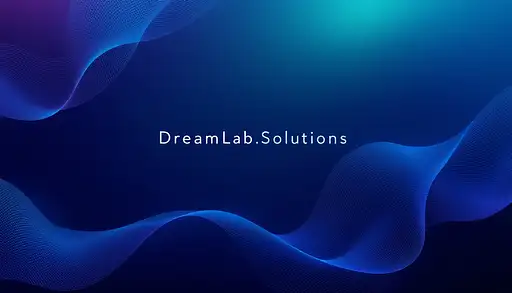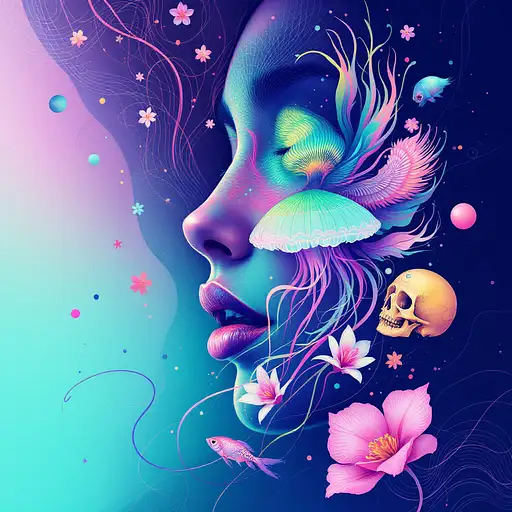9 months ago
Goddess close-up portrait ribcagel. jellyfish phoenix head, nautilus, orchid, skull, betta fish, bioluminiscent cre## Concept & Design Elements
1. **Overall Theme**
- **Look & Feel**: Clean, modern, minimalistic
- **Message**: You’re a strategic digital solutions partner offering user-centered innovation
- **Color Palette**: A primary color that resonates with you (e.g. a deep teal or navy) plus a bright accent color (e.g. light aqua, coral, or lime).
2. **Background**
- Use a **soft gradient** as the base:
- For example: **Deep Navy (#0a2239)** fading into **Teal (#1e6f8c)**
- Alternatively, a **clean white or very light gray** (#F5F5F5) background with subtle geometric shapes or line art in the corners.
3. **Visual/Graphic Motifs**
- **Abstract Geometric Shapes**: Curved lines or subtle wave patterns that hint at “flow” (conveying agile solutions)
- **Layered Overlays**: Transparent shapes at low opacity (e.g., 20% of your accent color) to add depth, plus angled lines suggesting forward momentum.
- **Iconic Imagery**: A simplified wireframe globe or connected nodes to symbolize digital strategy. Keep it stylized and subtle, not overly busy.
4. **Text Placement & Styling**
- **Your Name** (Large, clear font, e.g. Montserrat, Open Sans, or Lato)
- A short tagline or brand statement, for instance:
> *Digital Solutions & UX Strategist
> Empowering Businesses Through User-Centered Innovation*
- Keep the text to the left or center, leaving some negative space for a clean appearance.
- Make sure fonts are big enough to be legible on multiple devices, especially mobile.
5. **Hierarchy & Balance**
- **Name** or main title is the largest text element (e.g., 35–45 px in standard design software).
- **Tagline** is smaller (around 20–25 px), italic or a lighter weight to differentiate it.
- If desired, include bullet points or tiny icons (no more than 3) that represent key skills:
- **UX Strategy**
- **Business Transformation**
- **Product Development**
6. **Brand Accent**
- Use accent color behind a word or phrase in your tagline to draw the eye (e.g., “**Empowering** Businesses Through User-Centered Innovation”).
- Consider a small stylized icon (like a light bulb or puzzle piece) near your name for a subtle brand mark.
7. **Exporting the Final Image**
- **Aspect Ratio**: 16:9
- **Recommended Dimensions** (for clarity on various platforms): 1920 × 1080 px or 1600 × 900 px
- **File Type**: PNG or JPEG for broad compatibility, with at least 72 DPI (consider 150 or 300 DPI if you want a crisp image where possible).
---
## Quick Step-by-Step (If You’re Using a Design Tool Like Canva, Figma, etc.)
1. **Create a 1920×1080 canvas** (16:9 ratio).
2. **Apply a gradient** background (e.g. deep navy to teal) or a light neutral background with abstract shapes.
3. **Add your name** in a prominent spot.
4. **Add a short tagline** underneath or to the side.
5. **Incorporate abstract or geometric elements** (lines, shapes, or icons) at low opacity.
6. **Position text** so it’s clearly visible and not obstructed by platform profile pictures (especially on LinkedIn).
7. **Export** as a high-quality PNG/JPEG.
---
## Example Text Layout (Minimal Option)
+---------------------------------------------------------+
| [Soft Gradient Background / Abstract Shapes] |
| |
| [Your Name Here] |
| Digital Solutions & UX Strategist |
| Empowering Businesses Through User-Centered Innovation|
| |
| [Small icons or subtle shapes at bottom corners] |
+---------------------------------------------------------+
- **Name** in a strong font (e.g., Montserrat Bold, 40px).
- **Sub-text** (tagline) in a lighter weight or smaller size (24px).
---
### Final Tips
- Keep the layout uncluttered; negative space is key to a professional vibe.
- Test how the image crops on each platform (LinkedIn may place the user’s avatar over the left corner, etc.).
- Make sure your accent color doesn’t clash with the text readability.
- A short tagline is typically enough—avoid packing too much text into the banner.
This design approach should give you a versatile **16:9** header image that visually communicates your new brand identity as a strategic, user-centered digital solutions professional. Feel free to adapt the color palette, shapes, and text style to best reflect your personality and goals.atures, intricate artwork . octane render, trending on artstation,t symmetrical artwork. cinematic, hyper realism, high detail, octane render, 8k





